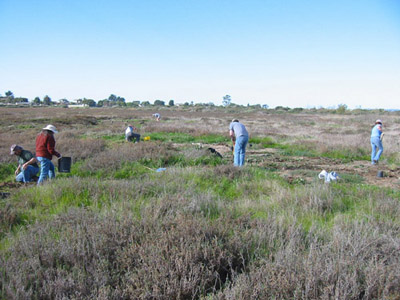After yesterday’s rain, today (Sunday) was clear and windy. Linda, William, and I took a walk at the Carpinteria bluffs, parking at Viola Fields and taking the trail down to the harbor seal viewing area and back.
The tide was lower, and the number of seals greater, than when we were there yesterday; it looks to me like there were close to 200 seals hauled out.

On our way back, Linda noticed a dead pelican on a ledge below the top of the bluffs. You can see it slightly left of center in this view towards Rincon:

Here’s a closer view, where you can see that this was an adult brown pelican, with the pretty cream plumage on the head and neck. It hadn’t molted into the chestnut breeding plumage it would have had soon if it had survived:

Apparently there have been a lot of brown pelicans dying in southern California since early January, some of them after acting disoriented and flying to unusual inland locations. Scientific American’s blog summarized news coverage of the story: Did bad weather kill, sicken California brown pelicans? As the title indicates, current suspicion focuses on a sudden winter storm the birds faced in the Pacific Northwest, which caused a large number of them to make an emergency trip south, leaving them exhausted and vulnerable. Could this bird have been one of those affected?
I also took some photos of plants along the trail, starting with that same Salvia species (I assume) that I’ve been trying to identify:

I also took this shot of what I believe is California saltbush:

And this shot of what I think is lemonade berry, currently in bloom with a lot of small, pink flowers:

Here’s a shot of the area behind the seal viewing overlook where Venoco has proposed a new oil drilling project. The Paredon project, as it’s called, is currently working its way through the environmental-review process.

You can read more — much, much more — about Paredon at the city’s community development project information page. The latest I’ve heard is that more work is being done on the EIR based on input from the city’s environmental review committee, and that the project might come before the planning commission sometime this summer, with the city council getting it sometime after that. There’s a good chance that whichever side loses the decision before the city council will then pursue some kind of public referendum.















